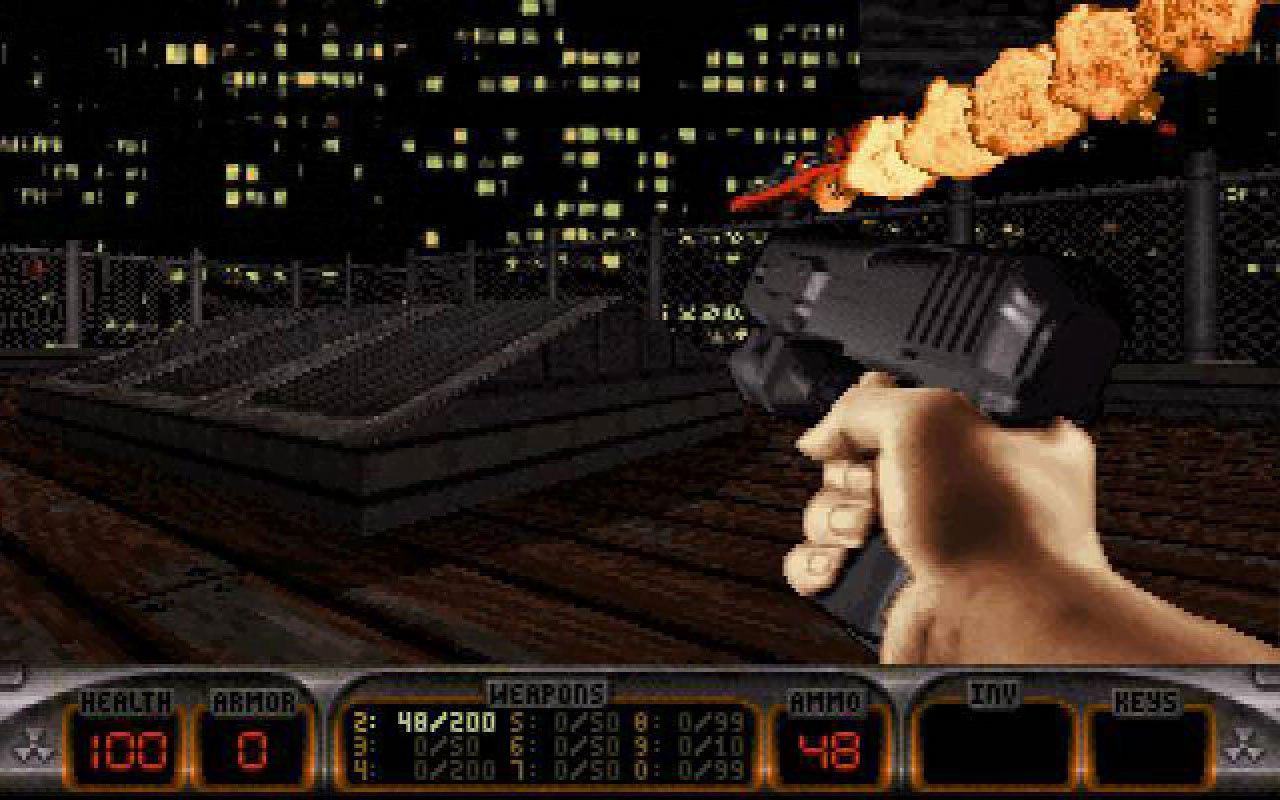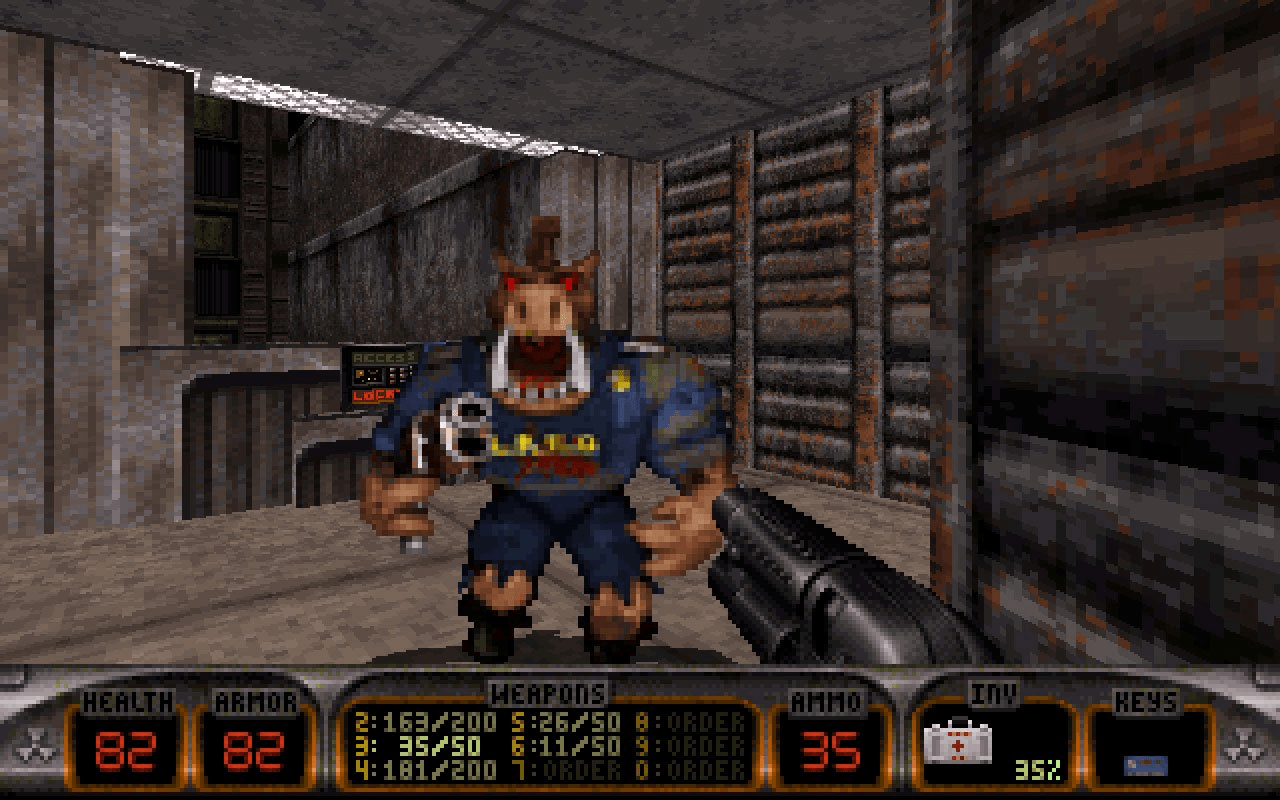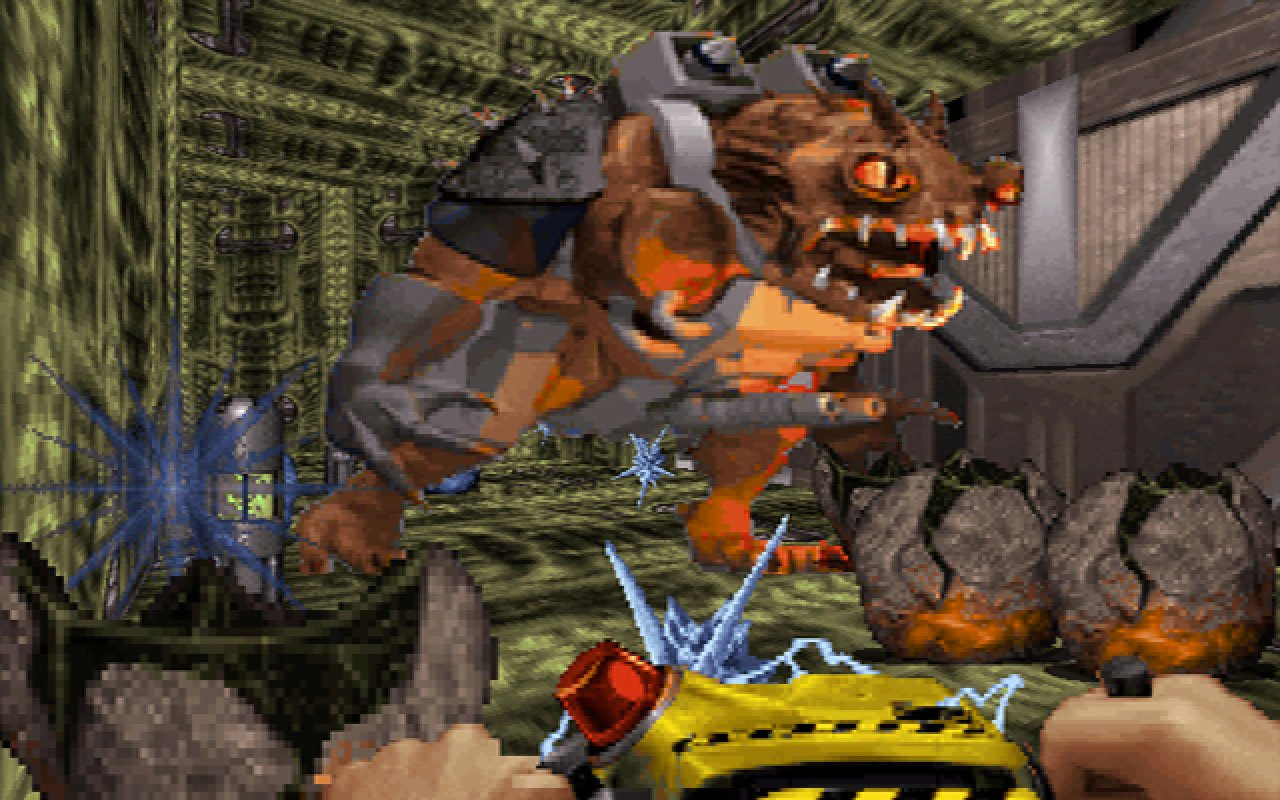More and more these game reviews are as much a chance to use the game as an avenue to talk about any old stuff I want to so let’s not kid ourselves, that’s what I’m gunna do.
So, Duke Nukem 3D. It’s a mediocre first-person shooter modelled on ‘Doom, but-‘ released to compete with Quake, an equally haphazard game that despite being a failure is still one of best videogames of its decade, no qualifications, no exceptions, Quake is, yes, that good, do not @ me. While id and Raven Software games sought to take a technical engine and wed it to solid fundamental play and design choices, 3D Realms strove to instead build their game with theming, making it all about being the coolest goddamn thing you could possibly be in 1996, and with that, carried the brand all the way into the Sonic The Hedgehog Franchise-Dumpster.
But while there’s a certain fondness that can persist for Sonic the Hedgehog, a franchise that picked up a lot of people when they were kids with ideals of environmentalism and friendship, Duke Nukem was…
Let’s say he’s got problems.
Duke’s Land Of Penis-Powered Vending Machines
Remember how I talked about how the world of Lion King was pathetic? In a literary sense, the notion is that The Lion King exists in direct reaction to and reflection of the humanity of the main characters, and in the case of The Lion King, they’re also represented as humans in non-human form. Pathetic is an interesting word, particularly the way it’s come to mean as an insult something worthless or meaningless, when what it derives from is connection to feelings. Just because something is pathetic doesn’t mean that it’s, you know, pathetic.
Hm, this will get confusing. Let’s ditch that phrasing.
This was conjured once more to my mind by observing the work of one Duke Nukem 3D, and its particularly nightmarish vision of a world that is entirely rendered in response to the creeping horror of being Duke Nukem. There are no other people in Duke Nukem’s world. There are no individuals with wants or ideals or opinions. Everyone either exists to oppose Duke Nukem or exists to satisfy his ego as payment for overcoming that opposition. This follows through to Duke Nukem Forever, where the world itself is a monument to Duke’s ego.
You could claim that this is a function of the Duke Nukem world being a videogame of its time, but it’s simply not true: every time a videogame came out with the Duke Nukem label, there is a contemporaneous game that was doing the same things, more or less, with more sense of a world, with less sense of the creepy childishness to it. This isn’t a ‘nobody knew how to make an interesting game’ kind of thing. This was a choice. NPCs and dialogue and characterisation aren’t interesting to this game – it simply doesn’t care. The world Duke lives in is the world they chose to make for him. And this is a character who in all preceding games was a fan of Oprah.
Duke Nukem lives in a land of vending machines. Some things, wave your death-penis at, and they deliver ego, some thing you stick your not-death-penis in, and they deliver, again, ego.

Individual enemies in Duke Nukem 3D are terrible designed. For the most part, enemies occupy one of four basic forms – a long-range hitscan enemy (whose weapon hits you instantly), a short-range ‘projectile’ enemy whose projectile is very fast moving and tiny on the screen, so it might as well hit you instantly, and one bazooka-ass enemy that could fly, and shoot perfectly at any angle while you had a limited range of 45 degrees to look upwards. There were other miscellaneous monsters, but that was your basic design: Hitscan weapons, almost hitscan weapons, and king-hit bazooka things that were hard to look at and harder to hit.
To deal with these threats you did get a wonderful basket of tricks to play with, which is to say, you got a range of weapons that were unnecessary and unuseful to use, like wallmines and pipe bombs and a shrink ray, weapons that were all much less pragmatically useful than just shooting your opponent with a shotgun, or the chaingun (a better shotgun), or the devastator (a better chaingun, but it had splashback). The idea of a wallmine or a pipebomb in the context of a shooter sounds interesting, and maybe they were useful in some way in PVP play, but the functional weapons were a very rudimentary good-better-best system.
I harp on about Doom’s weapon system and monster design and level design and being good, but there’s a reason why: It’s not that Doom is delicately balanced, it’s that Doom is varied, and variety required effort. A lot of enemies in Duke Nukem 3D are the same monster, and solved with the same strategy: You keep circle-strafing and shoot the thing. To make every monster look interesting, and varied would have required more art assets, more testing, and just more work.
And it’s not there.
I’m not saying Duke Nukem 3D is a lazy game. I’m saying it seems lazy. A laziness that shows through in the game’s world, and humour, and its characters, and its advertising and its approach to sequels and maybe I am saying it’s a lazy game. Either way, it is rubbish.
Marshal McLuahn Would Be Proud
Part of this is an entangled strangeness of the medium being the message. Game engines, in a way, are a microcosmic examination of the classic Marshal McLuahn soundbyte, The Medium Is The Message. That is, to put in this context how games work is much more of an impact than what the games are doing.
The Build Engine claimed at the time that it was to be a cutting-edge engine in the era of the first iteration of the Quake engine. It was just as good, if not better, it said, as that other engine that was so flexible and so powerful that modders could get the game to run versions of C, handle user interface changes from mods. A booklet was distributed by 3d Realms showing all the Build Engine games that were launching all at once, and were going to take over the FPS market – games like Blood, and Powerslave, and Witchaven and Prey.

I’ll give you a moment to think about the one game in that list that came out, and used the Build Engine, that you were able to remember.
The Build engine compared pretty well to the Doom Engine. Whereas id were shackled to John Carmack’s purist approach, and therefore refused to allow for things like invisible teleportation or float differences, things that could be used easily for cheap tricks, the Build Engine was under no such pretensions. The Build Engine was even willing to make fake architecture – unable to make ‘real’ 3d architecture, it could handle gantries and walkways that the game painted over. Essentially, the Build Engine was, without sharing any of the same DNA, capable of replicating the Doom engine, then allowing for a host of extra tricks like spaces-in-spaces, underwater areas, swimming, and flying, tricks that Raven software had had to squeeze out of the Doom engine in Heretic. Compared to Wolfenstein, Build is amazing. Compared to Doom, it’s pretty impressive – it manages most of the same systems and has room to add more stuff that gave level designers more tools.
Except Duke wasn’t lined up to compare to Doom.
Duke Nukem 3D launched two months after Quake released its shareware first episode.

Quake was a 3d engine game that had an actual 3d engine. It could put rooms over rooms, it could have complex architecture, it could manage delayed triggers and teleports and invisible sectors and timers and all sorts of stuff. It wasn’t a perfect engine at launch – there was a very sharp barrier for entry, and that happened to live between the SX and DX models of 486 processors – but the Quake engine was very good at being the Quake engine, and also doing things nothing else was doing. It was also fast, and had a deathmatch mode that, with a small amount of tweaking, could accommodate large groups of people in big maps that moved fast. Quake simpy put, was a better game for playing than Duke Nukem 3D.
One of the things Quake could do, and did, was handle triggers. In the Build Engine, it was remarkably challenging – and I know, I tried – to make a thing in the game act without the player directly causing it. You could nest triggers, so that the player tripping a wire in sector A would start a process in sector B, but if you wanted to do something in sector C, god help you. Players could intentionally cause things to happen, but the game world was simply static, endlessly quiet, waiting for the player to come along and make it start moving.
This meant that for all the game built itself around the feeling of being in a world space, with its toilets and its ventilation ducts and its wood doors (that behave like the unyielding law-fields of all other doors), is that Duke Nukem 3D is a deeply unreal world. Enemies don’t patrol – if you ever see them before they see you, they are quietly marching on the spot, or, more creepily, just hovering slightly above the ground. Because that’s the world of the Build Engine.
Nothing happens without you. Everything is set up for you. And the world created for you is this miserable, sterile facsimile. It is a world for you, it is a world entirely about you, and it is a world that reflects you. This world, they think, is what you want it to be. By making something for you, Duke Nukem 3D insults you on a deeper level than any intentional expression could.
It is a place of sex shops and random dancing women endlessly grinding by fireplaces in hidden crannies. It is a tour with a referential snide asshole who wants to ‘make fun’ of what he perceives as his personal cultural enemies, which is mostly about mentioning their names, then nudging his passenger with his elbow. Nudge nudge. Wink wink. I said that’s a Doomed Space marine. A Dooooomed Space Marine.
There’s nothing to say here. There’s no idea. There’s no personality, no spirit. There’s someone pre-emptively sneering at opposition that really doesn’t exist in the same space as him. It’s a high school reunion where the jock turns up and pre-emptively starts every conversation with how well he could kick your ass back then.
Duke Nukem 3D sucks.
And it’s always sucked.
We just didn’t notice.
Because we sucked too, oh my god.
Verdict
It’s available on Steam, and nowhere else, because Gearbox clamped right down on that.
Verdict
Get it if:
- Don’t.
Avoid it if:
- You’re older than twelve, now
